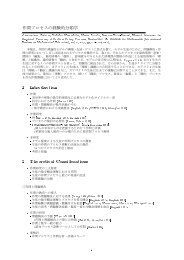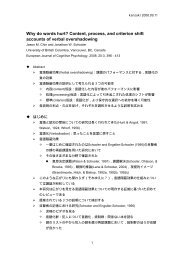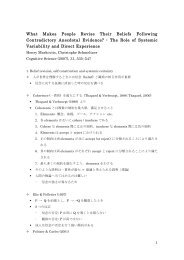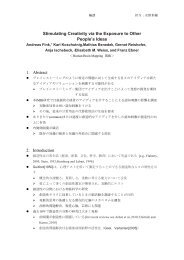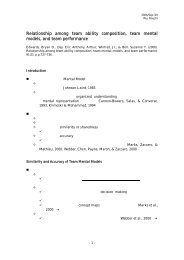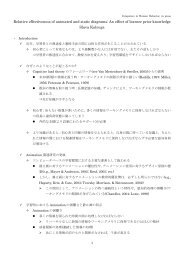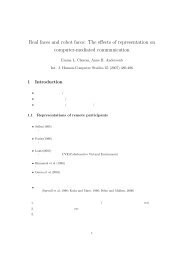THE JOURNAL OF THE LEARNING SCIENCE, 13(1) - 三輪研究室
THE JOURNAL OF THE LEARNING SCIENCE, 13(1) - 三輪研究室
THE JOURNAL OF THE LEARNING SCIENCE, 13(1) - 三輪研究室
Create successful ePaper yourself
Turn your PDF publications into a flip-book with our unique Google optimized e-Paper software.
<strong>THE</strong> <strong>JOURNAL</strong> <strong>OF</strong> <strong>THE</strong> <strong>LEARNING</strong> <strong>SCIENCE</strong>, <strong>13</strong>(1),15-42Design Research: Theoretical and Methodological IssuesAllan Collins, Diana Joseph, Katerine Bielaczyc”design experiments””design research”Ann Brown(1992)INTRODUCTIONDesign Science Versus Analytic ScienceHerbert Simon(1969) The Science of the Artificialnatural science sciences of the artificial(design science)science of the artificialSimon design science science of the artificial 1
Simon design science design science Collins(1992)Simon analytic(or natural) science design science Collins analytic sciencedesign science design science The Problem of Narrow Measures(Rosenbaum, 2001; Stasz, 2001)expert learners(Brown, Ellery, & Campione, 1998)expert learners 2
Characteristics of Design Research(Stigler & Hiebert, 1999) Diana Joseph(2000)Daniel Edelson(Edelson & Joseph, in revision; Joseph &Edelson,2002) motivational theory Brown and Campione(1996)design experiments 3
Characteristics of Other Research MethodsAnn Brown(1992)Collins(1999)1. Laboratory setting vs. messy situations2. A single dependent variable vs. multiple dependent variables3. Controlling variables vs. characterizing the situation4. Fixed procedures vs. flexible design revision5. Social isolation vs. social interaction6. Testing hypotheses vs. developing a profile4
7. Experimenter vs. co-participant design and analysisEthnographic researchanalytic science Eckert,1989Large-scale studies of educational interventionWhy Design Research?EXAMPLES <strong>OF</strong> DESIGN RESEARCHAnn BrownJoseph Campione Fostering a Community of Learners(FCL)Diana Joseph passion curriculum approach5
Brown and Campione’s FCL ClassroomBrown and Campione(1994, 1996; Brown, 1992)FCL FLC WEB “consequential task”jigsawgroup(Aronson, 1978) consequentialtaskFCL (Palincsar & Brown, 1984)6
Phase1.Brown and Campione(personal communication)Brown and CampioneFCL Jigsaw Jigsaw Phasediverse expertise community of learnersPhase2.Phase1.Darwiniam Lamarckian 7
Phase3.FCL Jigsaw cross talkcross talkFCL FCL 8
Diana Joseph’s Passion Curriculumpassion school passion school Phase 1.video crewJoseph Video Crew 9
Phase 2.Video Crew Joseph Daniel Edelson Edelson & Joseph, in revision; Joseph & Edelson, 200210
Phase 3.passion curriculum Multi-Media Design Studio 2002(Joseph & Nacu, submitted)METHODLOGY <strong>OF</strong> DESIGN RESEARCHImplementing a DesignBrown and Campione(1996)FCL 11
Modifying Designs as You ProceedMultiple Ways of LookingRogoff(1995)personal layer interpersonal layer community layerCognitive level Interpersonal levelGroup or classroom levelResource level Institutional or school level12
Characterizing Dependent Variables or Climate variable Learning variable Systemic variableCharacterizing Independent VariablesSettingor Nature of the learnersRequired resources and support for implementationProfessional developmentFinancial requirements Implementation pathReporting on Design ResearchGoal and elements of the design<strong>13</strong>
Settings where implementedCharacterizing independent variablesDescription of each phaseOutcomes foundLessons learnedCONCLUSIONBrown(1992)(Barab & Kirshner, 2001; Edelson,2001; Design-based Research Collective, 2003)14



